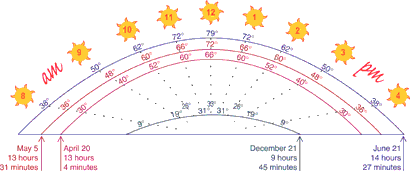| May 20, 1999 |
|
Previous Next |
||
|
|
||||
|
| ||||
 Last week, we saw that the Sun was higher in the sky on May 5th than it had been on April 20th, and the day was 27 minutes longer. But the days don't keep getting longer forever (at least they never have before!). So the question is, when will the days start getting shorter again? We have plotted several Sun tracks on our graph that help answer that. The red tracks are those we made over the last month. The blue ones represent the longest and shortest tracks we can expect in the next year in Los Angeles. I got this future data from looking at the sun tracker simulation in Whyville, or you can get it from the Griffith Observatory (www.griffithobs.org). The Sun will be its highest (and the day the longest) on June 21st, and the Sun will be the lowest (and the day the shortest) on December 21st. These days are known as the summer and winter solstices. Last week, we saw that the Sun was higher in the sky on May 5th than it had been on April 20th, and the day was 27 minutes longer. But the days don't keep getting longer forever (at least they never have before!). So the question is, when will the days start getting shorter again? We have plotted several Sun tracks on our graph that help answer that. The red tracks are those we made over the last month. The blue ones represent the longest and shortest tracks we can expect in the next year in Los Angeles. I got this future data from looking at the sun tracker simulation in Whyville, or you can get it from the Griffith Observatory (www.griffithobs.org). The Sun will be its highest (and the day the longest) on June 21st, and the Sun will be the lowest (and the day the shortest) on December 21st. These days are known as the summer and winter solstices.
| ||||
|
Next week, we will consider what the sun is doing in other spots on the Earth. So have your distant friends and relatives do their experiments, too. Remember, we need everyone's data next week. See you then! | ||||
| Whyville Square | Introduction | Series 1: Spinning | Series 2: About Time | Times Building Entrance | Log Out |